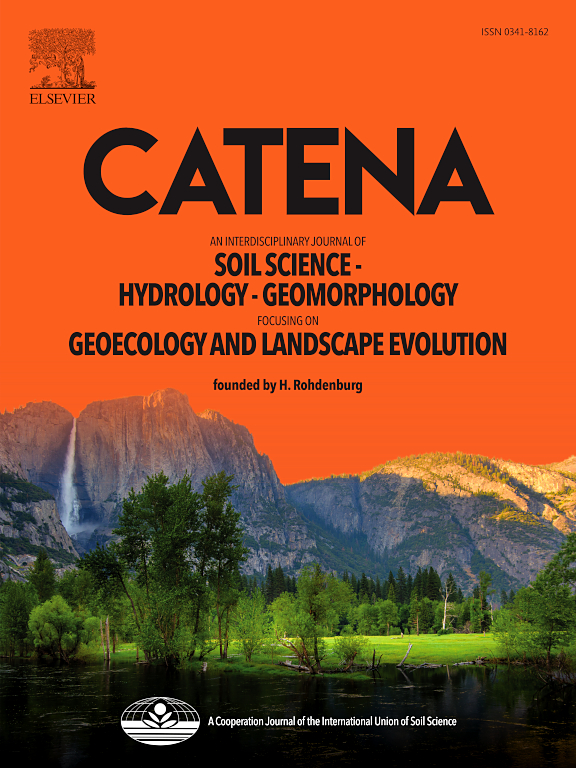Water erosion control through vegetation restoration: Mechanisms and contributions of vegetation components in Robinia Pseudoacacia forests
IF 5.4
1区 农林科学
Q1 GEOSCIENCES, MULTIDISCIPLINARY
引用次数: 0
Abstract
Soil erosion represents a critical environmental challenge, with vegetation restoration recognized as an effective biological strategy for mitigating water erosion. However, much research has examined how vegetation components regulate water erosion in grassland ecosystems, but these conclusions may not apply to more complex forest ecosystems. This study investigated 42 typical Robinia pseudoacacia forest plots, assessing water erosion characteristics under four scenarios: full vegetation components including grass canopy, litter layer and shallow roots (GLR), retention of litter layer and shallow roots (LR), retention of shallow roots only (R), and no vegetation components (N). These characteristics involved average flow velocity (V), Reynolds number (Re), Froude number (Fr), Weisbacher-Darcy resistance coefficient (f), sediment concentration (C), soil loss rate (SLR), runoff shear stress (τ), runoff power (W), and critical runoff shear stress (τc). Contributions of the grass canopy, the litter layer, and the shallow roots in mitigating water erosion were quantified. The aim of this study is to analyze the influence of each vegetation component separately on soil erosion. The results indicated that the grass canopy significantly increased f and τc. The litter layer substantially reduced V, Re, Fr, C, SLR, and W, while increasing F, τ, and τc. The shallow roots significantly reduced V, Re, Fr, C, and SLR, while increasing τ and τc. Litter layer exerted a more pronounced impact than shallow roots and grass canopy, possibly attributed to the substantial litter biomass. Promoting the formation and accumulation of litter layer, along with shallow roots supporting, helps to optimize the soil and water conservation functions of forest ecosystems. These findings enhance understanding of the mechanisms and contributions of vegetation components in controlling water erosion on the Loess Plateau, particularly within complex forest ecosystems.
植被恢复控制水土流失:刺槐林植被组分的作用机制及贡献
土壤侵蚀是一个严峻的环境挑战,植被恢复被认为是缓解水土流失的有效生物策略。然而,许多研究已经研究了植被成分如何调节草地生态系统中的水分侵蚀,但这些结论可能不适用于更复杂的森林生态系统。本研究以42个典型刺槐林样地为研究对象,评估了4种情景下的水分侵蚀特征:全植被组分包括草冠层、凋落物层和浅根(GLR)、凋落物层和浅根截留(LR)、仅浅根截留(R)和无植被组分(N)。这些特征包括平均流速(V)、雷诺数(Re)、弗劳德数(Fr)、weisbacer - darcy阻力系数(f)、泥沙浓度(C)、土壤流失率(SLR)、径流剪切应力(τ)、径流功率(W)和临界径流剪切应力(τ C)。定量分析了草地冠层、凋落物层和浅根对缓解水土流失的贡献。本研究的目的是分别分析各植被成分对土壤侵蚀的影响。结果表明,草冠层显著增加了f和τc。凋落物层显著降低了V、Re、Fr、C、SLR和W,增加了F、τ和τ C。浅根显著降低了V、Re、Fr、C和SLR,同时增加了τ和τ C。凋落物层比浅根和草冠层的影响更明显,这可能与凋落物生物量较大有关。促进凋落物层的形成和积累,以及浅根的支撑,有助于优化森林生态系统的水土保持功能。这些发现加强了对黄土高原,特别是复杂森林生态系统中植被成分在控制水分侵蚀中的机制和贡献的认识。
本文章由计算机程序翻译,如有差异,请以英文原文为准。
求助全文
约1分钟内获得全文
求助全文
来源期刊

Catena
环境科学-地球科学综合
CiteScore
10.50
自引率
9.70%
发文量
816
审稿时长
54 days
期刊介绍:
Catena publishes papers describing original field and laboratory investigations and reviews on geoecology and landscape evolution with emphasis on interdisciplinary aspects of soil science, hydrology and geomorphology. It aims to disseminate new knowledge and foster better understanding of the physical environment, of evolutionary sequences that have resulted in past and current landscapes, and of the natural processes that are likely to determine the fate of our terrestrial environment.
Papers within any one of the above topics are welcome provided they are of sufficiently wide interest and relevance.
 求助内容:
求助内容: 应助结果提醒方式:
应助结果提醒方式:


